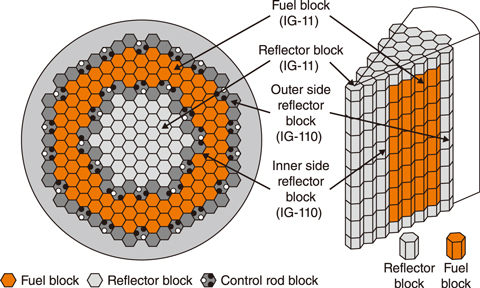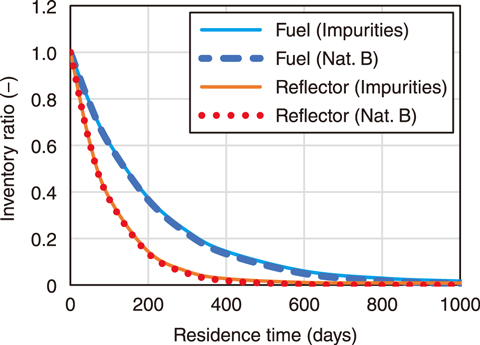
Fig.6-2 Horizontal cross-sectional view (left) and bird’s-eye view (right) of the GTHTR300 core

Fig.6-3 Burnup characteristics of impurities in the fuel and reflector blocks
In HTGRs, impurities such as boron and iron present in graphite can negatively impact the criticality. The HTTR was designed with IG-110 high-purity graphite blocks in the fuel region to reduce the influence of these impurities on the criticality. In contrast, the high-temperature gas turbine power-generation system, the Gas Turbine High-Temperature Reactor 300 (GTHTR300) was initially designed using only IG-11 graphite blocks, which have a lower purity than IG-110, for economic efficiency, although it was later redesigned to employ IG-110 over concerns regarding the criticality (Fig.6-2). However, as commercial reactors require high economic efficiency, the GTHTR300 would be a more attractive proposition if the core could be established using only inexpensive IG-11 graphite blocks. To do this, it is necessary to show that sufficient criticality can be achieved using the inexpensive IG-11 graphite blocks. This work therefore investigated the burnup of impurities in the graphite. Due to their large absorption cross-section, impurities with a strong poisonous effect should be burned up quickly. Thus, if it is confirmed that these impurities burnup in the early stages of the cycle, it can be confirmed that the criticality is not affected and that there is only a negligible effect on the cycle length.
However, to perform such a calculation, it is necessary to simulate a burnup of the entire core, which deals with the burnup of all the impurities in graphite. The number of nuclides that can be treated by the burnup chain model of the entire core calculation is limited to the important ones for the evaluation of the core characteristics, and it is not realistic to treat the burnup of all nuclides in the entire core calculation because the post-implementation data is too complex to maintain. For this reason, a radionuclide decay production calculation code ORIGEN was first used to evaluate the burnup characteristics of impurities for the GTHTR300 design. The calculation results indicated that the burnup of these impurities can be simulated by the burnup of natural boron as a representative impurity, as shown in Fig.6-3. The impurities in IG-11 were thus converted to boron equivalents and the burnup calculation of the entire core was performed using the burnup calculation code using the Monte Carlo method (MVP-BURN). This analysis indicated that using the IG-11 graphite blocks causes an increase in the cycle length by approximately 10% when compared with the conventional GTHTR300 design, which does not consider the burnup of impurities. In the conventional design, impurities are assumed to remain even at the End of Cycle (EOC), thus accounting for this increase.
These results indicate that the impurities found in graphite burnup before the EOC, and these impurities do not interfere with the criticality at the EOC, even when the lower-cost IG-11 graphite blocks are used in the design.
Future efforts will focus on further economic improvements to the HTGR design such as revising the shuffling pattern of the fuel block to improve burnup.
(Shoichiro Okita)
<Previous: 6 HTGR Hydrogen and Heat Application Research | Next: 6-2>